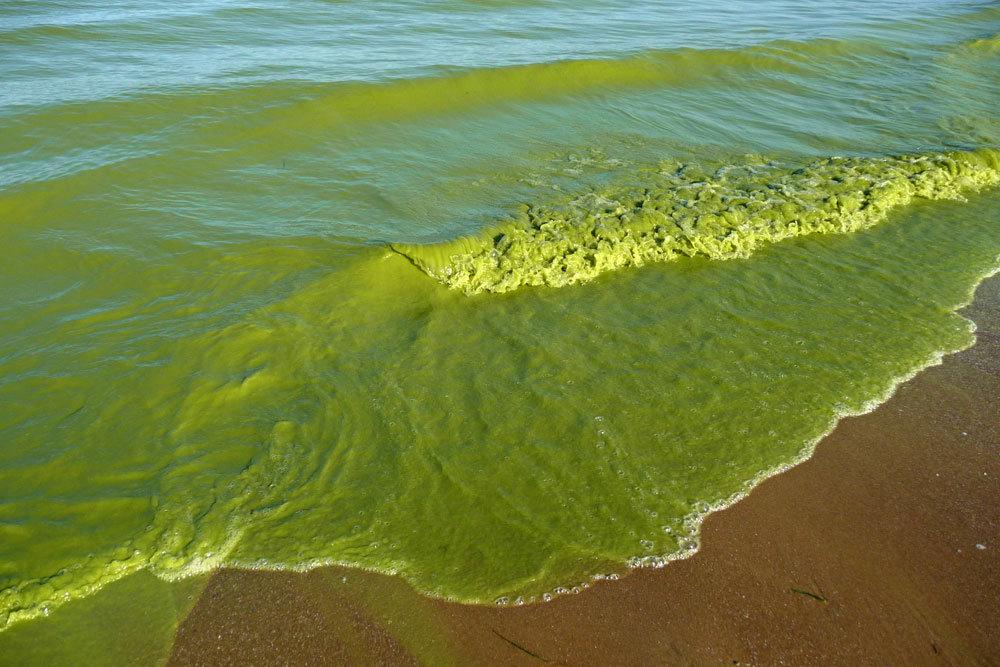Water supplies meeting treatment requirements
Water Treatment & Algal Toxins
Back to Compare
Algal Toxins

Summary
- Excess nutrients in water bodies may result in Harmful Algal Blooms or HABs, largely made up of one or more species of cyanobacteria, also known as blue-green algae. HABs may produce toxins, also called cyanotoxins, that can be harmful to human and animal health
- The U.S. EPA has created health advisory levels in drinking water for specific cyanotoxins ranging from 0.3-3 ppb depending on the type of toxin and target population
- To determine the best technique to treat for algal toxins, managers need to consider the type of cyanotoxin and whether it is present inside or outside the cyanobacterial cell
What are algal toxins?
Harmful Agal Blooms (HABs) are overgrowths of cyanobacteria, a group of photosynthetic bacteria, some of which produce a group of algal toxins called cyanotoxins. In high doses these cyanotoxins may cause human health risks for drinking water. Common symptoms of HAB toxicity include gastrointestinal symptoms like nausea, vomiting, abdominal pain and diarrhea, neurologic symptoms, headache, and fever.
Where do toxins come from?
The overgrowths, or blooms, of cyanobacteria in surface water bodies are often caused by elevated nutrient levels, high water temperatures, and low water flows. The conditions that cause cyanobacteria to form cyanotoxins are not well understood and cyanotoxin levels can vary from year to year, even in the same water body.
What are the contamination standards?
The U.S. EPA has created drinking water health advisory levels for two cyanotoxins and some states such as Ohio have taken action to enact standards for additional cyanotoxins. Microcystins levels are advised by the U.S. EPA to be at or below 0.3 ppb for children under six and 1.6 ppb for people over six. Health Canada sets a maximum acceptable concentration at 1.5 ppb. Similarly, the maximum advisable level for cylindrospermopsin is set at or below 0.7 ppb for children under six and 3.0 ppb for people over age six according to the U.S. EPA.
How is drinking water treated to meet applicable standards?
Conventional drinking water treatment processes may treat for cyanobacteria and cyanotoxins; however, during bloom periods, cyanotoxins run the risk of breaking through treatment processes and entering finished drinking water. Active management and monitoring are important steps to reduce this risk of contamination.
Within treatment types there are options to remove cyanotoxins while they are contained within cyanobacterial cells (the intracellular stage) versus options to remove toxins which have been released from cells (the extracellular stage). To determine the best technique to treat for algal toxins, managers need to consider the type of cyanotoxin and whether the toxin is in the intracellular or extracellular stage. Removing the cyanobacteria can remove the toxin in the intracellular stage, but extracellular toxins are harder to remove as they require removal through chemical or adsorptive means.
There are several options to treat intracellular cyanotoxins. The conventional treatment of surface water generally provides adequate removal of intact cyanobacterial cells and intracellular cyanotoxins. Flotation is also an effective intracellular removal technique since many cyanobacteria are buoyant. This includes Dissolved Air Flotation. Membranes offer an effective method in that microfiltration and ultrafiltration will efficiently remove cyanobacteria with frequent cleaning during blooms. Pre-treatment oxidation frequently runs the risk of lysing cyanobacteria and releasing cyanotoxins. Managers should make decisions to either use low doses of oxidant or use sufficiently high doses to destroy total cyanotoxins.
Extracellular removal is often harder. Reverse osmosis and nanofiltration are effective at removing some types of extracellular cyanotoxins, but not all cyanotoxins can be removed using these membrane techniques. Oxidation may be an effective treatment for some cyanotoxins. Potassium permanganate, ozone, and free chlorine have been found to be efficient at removing some types of cyanotoxins, although this is dependent on water chemistry. UV radiation is not an effective treatment option for cyanotoxins when used alone, however advanced oxidation which combines UV radiation with ozone or hydrogen peroxide is effective treatment for some cyanotoxins at high levels.
Activated carbon adsorption is an accepted treatment technique for removing cyanotoxins in the extracellular stage. Both powdered activated carbon (PAC) and granular activated carbon (GAC) are effective dependent on water quality conditions, carbon concentrations, and contact time. Treatment systems are estimated to cost approximately $0.45/1000 gallons of treated water. Optimized biological filtration has been shown to be effective at removing most cyanotoxins through biodegradation, but many factors cannot be easily controlled in this process such as acclimation periods and water quality.
References
- Water Quality & Health Council, Harmful Algal Blooms: Cyanobacteria and Safe Drinking Water (2018). Accessible online: https://waterandhealth.org/safe-drinking-water/treatment/harmful-algal-blooms-cyanobacteria-and-safe-drinking-water/
- EPA, Harmful Algal Blooms and Drinking Water Factsheet (2016). Accessible Online: https://www.epa.gov/sites/default/files/2016-11/documents/harmful_algal_blooms_and_drinking_water_factsheet.pdf
- Great Lakes HABs Collaborative, Harmful Algal Blooms and Human Health Effects (2022). Accessible online: https://www.glc.org/wp-content/uploads/HABS-FactSheet-Chronic-Health-202205.pdf
- Government of Canada, Guidelines for Canadian Drinking Water Quality – Summary Table (2020). Accessible online: https://www.canada.ca/en/health-canada/services/environmental-workplace-health/reports-publications/water-quality/guidelines-canadian-drinking-water-quality-summary-table.html
- EPA, 2015 Drinking Water Health Advisories for Two Cyanobacterial Toxins (2015). Accessible Online: https://www.epa.gov/sites/default/files/2017-06/documents/cyanotoxins-fact_sheet-2015.pdf
- EPA, EPA Drinking Water Health Advisories for Cyanotoxins. Accessible online: https://www.epa.gov/cyanohabs/epa-drinking-water-health-advisories-cyanotoxins
- EPA, Managing Cyanotoxins in Public Drinking Water Systems. Accessible Online: https://www.epa.gov/ground-water-and-drinking-water/managing-cyanotoxins-public-drinking-water-systems
- Ohio EPA, DRAFT WHITE PAPER ON CYANOTOXIN TREATMENT (2016). Accessible online: https://epa.ohio.gov/static/Portals/28/documents/hab/Algal%20Toxin%20Treatment%20White%20Paper%20FINAL%20November%202016.pdf
- American Water Works Association and the Water Research Foundation, Managing Cyanotoxins in Drinking Water: A Technical Guidance Manual for Drinking Water Professionals (2016). Accessible online: https://www2.illinois.gov/epa/topics/water-quality/monitoring/Documents/ManagingCyanotoxinsinDrinkingWater_Sept2016.pdf
- EPA, Water Treatment Optimization for Cyanotoxins (2016). Accessible online: https://www.epa.gov/sites/default/files/2018-11/documents/water_treatment_optimization_for_cyanotoxins.pdf
- Association of State Drinking Water Administrators, PFAS Treatment Options and Considerations for Drinking Water Utilities (Webinar) (2018) Study by Purolite. Accessible online: https://www.asdwa.org/past-events-webinar-recordings/?mgs_158=pfas&mgi_158=14529/pfas-treatment-options-and-considerations-for-drinking-water-utilities
